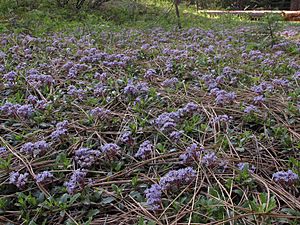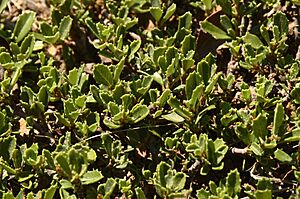Prostrate ceanothus facts for kids
Quick facts for kids Prostrate ceanothus |
|
|---|---|
 |
|
| Scientific classification | |
| Genus: |
Ceanothus
|
| Species: |
prostratus
|
Ceanothus prostratus, also known as prostrate ceanothus, pinemat, or mahala mat, is a type of shrub. It belongs to the Rhamnaceae family. This plant grows naturally in the Pacific Northwest part of the United States. You can find it in conifer forests and open, flat areas.
Contents
What Does the Pinemat Look Like?
The Ceanothus prostratus is a low-growing shrub. It spreads out like a mat on the ground. It usually stays less than 0.3 meters (about 1 foot) tall. However, it can spread wide, up to 3 meters (about 10 feet) across!
Its leaves are evergreen, meaning they stay green all year. They grow in pairs, one across from the other. The leaves are usually oval-shaped. They have 3 to 9 sharp teeth along their edges.
The plant's flowers grow in clusters that look like umbrellas. These flowers can be blue, purple, or lavender. They bloom between April and June. After the flowers, small, round fruits appear. These fruits have little "horns" on them.
Where Does the Pinemat Live?
The Ceanothus prostratus grows in the understory of mixed conifer forests. This means it lives under taller trees. You can find it from the lower hills up to high mountain areas.
It also grows in open, flat lands and on ridges. It likes dry forest areas too. This plant can be found at many different heights, from about 270 meters (885 feet) to 2700 meters (8,858 feet) above sea level.
Where Can You Find the Pinemat?
You can find Ceanothus prostratus all over the Pacific Northwest. Its range includes Washington, Oregon, western Idaho, and western Nevada. It also grows south into northern California.
The southernmost place it naturally grows is the central Sierra Nevada mountains. Because it grows at many different elevations, you can also find this plant in other mountain ranges. These include the Klamath Mountains, Siskiyou Mountains, Cascade Range, and Warner Mountains.
How Does the Pinemat Interact with Nature?
Ceanothus prostratus is part of a group of Ceanothus plants called Cerastes. These plants often have leaves that grow opposite each other. They also have special "horned" fruits, which is why they are called Cerastes (from the Greek word for "having horns").
This group of plants started to become many different types about 6 million years ago. This happened when the weather got cooler and drier. Also, the Coast Ranges rose up, creating new places for plants to grow.
Ceanothus prostratus is good at fixing nitrogen in the soil. This means it helps add important nutrients to the ground. It often grows near another plant called Purshia tridentata. Together, they can add a lot of nitrogen to their habitats each year.
This plant is also a host for a special parasitic plant called Cuscuta jepsonii. A parasitic plant gets its food from another plant. This dodder was once thought to be extinct. But it might still be surviving and growing on C. prostratus in northern California.
After areas are logged (when trees are cut down), more sunlight reaches the ground. Ceanothus prostratus is one of many plants that grow quickly in these open areas. They can form thick patches of brush.
Types of Pinemat
There are two main types, or varieties, of Ceanothus prostratus.
Western Pinemat
The first type is C. prostratus var. occidentalis (McMinn). This variety grows in the Coast Ranges and Klamath Mountains of northern California. It lives at elevations from 270 to 1400 meters (885 to 4,593 feet). This type grows more like a low mound than a flat mat. Its leaves are often folded lengthwise. Its fruits have horns that spread outwards.
Common Pinemat
The second type is C. prostratus var. prostratus. This is the most common type and covers most of the plant's range. It grows at higher elevations, from 800 to 2700 meters (2,624 to 8,858 feet). You can find it in the Klamath Mountains, Coast Ranges, High Cascades, High Sierra Nevada, and the Modoc Plateau. This variety forms a flat mat. Its leaves are usually unfolded, and its fruits have horns that stand straight up.



